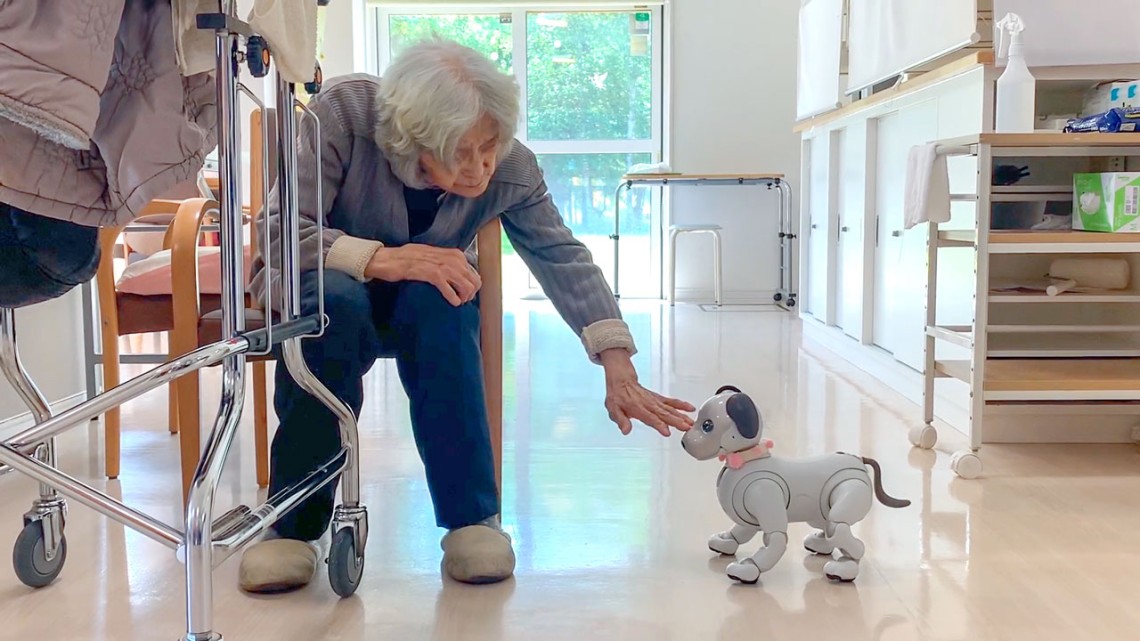
A woman greets a donated Sony aibo social robot at a senior care facility in Japan’s Hokkaido region.
Death of a robot: Repairing robots fosters social bonds
By Louis DiPietro
The news of a proper Buddhist funeral being held in Japan for more than 100 defunct robotic dogs initially struck Waki Kamino as odd.
But after a summer spent in Tokyo conducting hundreds of interviews with owners of social robots, Kamino – a doctoral student in the field of information science and a robotics researcher – came to understand the emotional and practical aspects of the funeral itself. She also happened upon a central premise in her latest research: a social robot’s death can inform its design.
“The funeral was a way for owners to donate their robots, providing owners emotional closure rather than simply discarding them,” Kamino said. “I think people tend to see repair and breakdown negatively, but in this case, they were using it as a positive moment of connection and emotional resonance with other robot owners.”
Kamino is the lead author of “The Lifecycle of Social Robots: Obsolescence and Values in Repair,” which was presented at the 33rd Institute of Electrical and Electronics Engineers International Conference on Robot and Human Interactive Communication in August. Malte Jung, associate professor of information science in the Cornell Ann S. Bowers College of Computing and Information Science and the Nancy H. ’62 and Philip M. ’62 Young Sesquicentennial Faculty Fellow, and Selma Šabanović, professor in the Luddy School of Informatics, Computing, and Engineering at Indiana University, are co-authors.
In the paper, the research team argues that repair and maintenance should be central in the design of social robots, which are robots that people interact with. Not only does reuse keep robots working longer and support sustainable practices, but, as researchers found, it also brings robot owners together and fosters social bonds among them.
It’s the trio’s second paper that attempts to broaden what constitutes design in the field of human-robot interaction by examining not just functionality and appearance but the entire ecosystem around the robot: the connection owners have with their robots, social bonds that form among robot owners, and the daily rituals in which robots accompany their owners.
“We can’t understand what makes a robot social by just looking at the machine,” Jung said. “We have to look much more at what's going on around the robot.”
In Tokyo, which has a strong community of social robot owners, Kamino visited robot meet-ups in cafés and conferences. She spoke to representatives of A-FUN, a robot repair company, and both SHARP and Groove X, which along with manufacturing social robots also charge owners tiered subscription fees to keep robots’ software up to date.
Some of the most illuminating conversations with owners involved death, Kamino said.
“We were asking people about how they live with the robots and what their lives are like. We quickly realized there was much more to it,” she said. “They were all thinking about the ending as well.”
Many expressed concerns that their robots would be rendered obsolete if the manufacturer chose not to update their social robots’ software and offer repairs, a doomed fate that met Sony’s AIBO robot after its production was initially discontinued in 2006. Other owners worried about securing care for their social robots after they died. “Some of them had already set up a custodial deal,” Kamino said.
These concerns point to the deep connections humans can have with machines and can be valuable in understanding what helps or hinders social robots’ adoption, Kamino said.
“We have to expand beyond considerations of initial adoption and design features,” she said. “We have to look longer term and consider the end-of-life cycle of a robot and how to reuse it in a second life, because that affects the way people perceive their robots and their willingness to adopt one.”
Louis DiPietro is a writer for the Cornell Ann S. Bowers College of Computing and Information Science.
Media Contact
Get Cornell news delivered right to your inbox.
Subscribe
